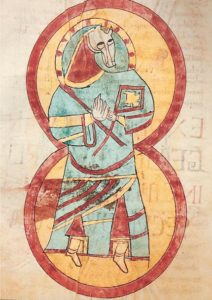Auction : History roll ~ Psalterium ~ Horae …
Sur ebay, plusieurs pièces intéressantes. Les notices sont celles des vendeurs …
§ Un document d’origine française assez exceptionnel: une pancarte chronique du XIVe s.

Comment Godefroy de Billon conquist Ierusalem et en fut fait roy. etc
A 14 or 15th century sheet of parchment (125 x 57 cm) which traces the history and descent of the Popes, the Holy Roman Emperors, the Kings of France and of the Latin Kingdom of Jerusalem.
Lot 111 in the celebrated Hauck sale (the History of the Book, 28 june 2006) was the last time to my knowledge that a complete roll came up for auction 55.5 x 1915cm (63’10\ » x 1’10\ ») and made a staggering 140.000 $.
In the last section of the sheet, the following genealogy of kings and queens is mentioned:
Philip IV (April-June 1268 – November 29, 1314)
Philip V (c.1292/93 – 3 January 1322)
Blanche of Valois (1317–1348)
On left side is a list with popes
Clement VI (1342-52)
Innocent VI (1352-62)
Urban V (1362-70)
Gregory XI (1370-78)
Urban VI (1378-89)
As I can figure out the segment next to Clement VI talks about indulgences, and I take this to refer to the Bull Unigenitus, January 27, 1343, in order to justify the power of the pope and the use of indulgences.
For it says in the HAUCK catalogue:
Other versions survive, showing that it was a composition (meaning the history of the kings of France, the conquest Jerusalem etc) that was repeatedly updated to provide a pedigree for the current King of France. For example the introduction to the manuscript in Paris (Bib. Nat. MS fr. 61) that ends with Charles VII (d.1461) declares the scope of the work to continue until 1375 and Charles V. The copyist obviously overlooked this anachronism. There is a similar scribal oversight in the present manuscript showing that this too was an updated copy of an earlier text.
Four other Chronicle rolls closely related to the Hauck manuscript and apparently copies of the same version are in the New York Public Library, MS 124 (New York, Metropolitan Museum of Art, The Secular Spirit: Life and Art at the end of the Middle Ages, 1975, p.166), Cambridge, Mass., Houghton Library, bMS Typ 41 [Link] (Roger Wieck, Late Medieval and Renaissance Illuminated Manuscripts 1350-1525 in the Houghton Library, Cambridge, Mass. 1983, pp. 22-23), A roll in the London Borough of Croydon Archive and a roll formerly the property of the Earl of Derby sold at Christie’s, London, 26 November 1997 lot 5, for £40,000.
Illumination:
There are three miniature roundels: two of a king and one of a knight or king in a boat. Most likely depicting Godefroy de Bouillon on board a ship to conquer the Holy land (his name is mentioned in the manuscript). In the text 39 illuminated capitals, in blue with burnished gold.
Link: ebay Item number: 300198922634
§ Un psautier-hymnaire du XIV. Sud de la France, ou Italie.

111 f. 142 x 102 mm
Description: Measures approx. 6\ » x 4.25\ » (142 x 102mm) Collation is as follows: (1-11(8), 12(9) (of 10, lacking v, a blank? exised during construction?, a3(8), 14(6). 11 and vIII are blanks, as both 141 and v1. Both 1(8) and 14 have been folded back to form fly leaves when the present binding was put on. 28 lines written in a round gothic bookhand in dark brown and black ink. In two columns, except for the Kalendarium, between 4 verticals and 29 horizontals. Justification, written space 102 x 71mm; rubrics in red. Two-line initials in red or blue to begin with; hymns and canticles with penwork infill decoration and flourishes extending into margins. Each sentence beginning with a one-line initial in alternate red and blue. Eight historiated initials (Five seven-line; two six-line, and one five-line). Of very high quality. Some rubbing in places with a slight loss of text (except under UV light) at 12.8 recto. Written in one main hand, with a few additions by two other hands, the neater of which may have written the Kalendarium. There is no foliation, but 12 of the 14 gatherings have catchwords at the bottom of the verso of their last leaf, answered by the first word of the next gathering. These are from gatherings 2 to 13 inclusive. Content: (1) Kalendarium. (1.2 recto to 1.7 verso). Then (2) The 150 Psalms, interspersed with 25 hymns, dominical and ferial, with canticles, antiphons, and rubrics for offices of Lauds, Prime, Terce, Sext etc. (On 2.1 recto to 12.1 verso column a). Then (3) Hymns, Canticles, including Magnificat, Nunc Dimittis, TeDeum etc and Litany. The main text begins at 2. 1 recto with Incipit Liber Hymnorum vel Soliloquiorum Prophetans de Christo etc. Quire 12 has nine leaves. One leaf (the 5th in order) has been neatly removed, leaving only a stub. One would expect the bibliofola to conjunct thus; 1+10, 2+9, 3+8, 4+7, 5+6 but 5 is not conjunct with 6. Without stressing the binding, it is difficult to see its fellow. However it may have been cut out during the writing of this quire, as otiose. Comparison with the list of saints invoked in the Litany in York Minister Library Psalterium XVI.0.19 (of the 13th Century) reveals that ‘Omnes Sancti Confessores’ is immediately followed by ‘Sancta Maria Magdalena’. This is exactly the same sequence as we find here from the last entry on 12.4 verso and the and the first entry on the recto of the next text leaf. There is the further point that had a text leaf been lost, it would have had to contain an additional 112 saints names. For both these reasons, it seems safe to conclude that no text is missing, and that this handsome volume from circa 1350 A.D.
Illumination: The subjects of the historiated initials, and their placing are as follows: 2.1 Recto: Beatus Vir Qui. (Psalm 1) King David against cobalt blue background; the aged King plucks a four-stringed harp and wears a golden crown and halo. 3.5 Verso: Dominus Illuminatio Mea. (Psalm 26). S.James the Great. Against a pink oval field, clutching a black cross, with his left side covered by a lime green gown. Also a rough brown hair shirt etc. 5.4 Verso. Dixit Insipiens. In Corde Suo. (Psalm 52). A Fool against a light blue background, wearing a five-pointed jesters crown, and a three-buttoned orange tunic. His right hand loosely grips a curiously-headed rattle. There are further miniatures for Psalm 68 (S. Laurence); Psalm 80 (S.Benedict?), Psalm 97 (St. Barbara) and Psalm 109 (Christ). The 150 Psalms were sung each week. The historiated initials placed at the head of the Psalms mentioned, mark the first Psalms for Matins each day, and the first Psalm for Sunday Vespers. Hence there are, as there should be, eight such initials. The Hymarium with its 68 hymns begins at 12.8 recto. Its beginning is marked by an initial ‘P’ (for Primo dierium omnium). The figure which would originally have been within the bowl of the ‘P’ has, puzzingly, been rubbed out. (May one guess at a saint who subsequently fell into disfavour, or who’s feast was suppressed?)
Binding: The hollow back indicates the present binding to be later than 1770, probably 19th century. The covers are blindtooled to a panel design using a 7-line fillet, Inside this border is an intricate interlace pattern etc. Vellum pastedowns and rougher parchment endleaves. The four compartments of the spine are decorated with an X pattern framed by a 3-line fillet on each side. The sewing does not correspond with the three false raised bands, and its brightness suggests it may well be contemporary with the binding. The slight worming in the gutter margin of the Kalendarium leaves is not continued into the Incipit leaf which follows. This, coupled with the different hand of the Kalendarium from that of the main text, may suggest that the Kalendarium was written a little later than the main text.
Dating: A terminus post quem for the Kalendarium is provided by the presence of Peter Martyr O.P. among the April Saints. He was not canonised until 1253. A terminus for the main text is given by the inclusion (13.5 recto) of the Feast of Corpus Christi, whose observance was commanded by Urbanus IV in the Bull Transiturus of 1264. The liturgical, gothic bookhand remained remarkably consistent even to the end of the 15th century, but to suggest a date in the middle of the 14th century would seem reasonable. (1270 A.D.-1350 A.D.) Colouring and stylistic features of the historiated initials are both consonant with this date of 1350 A.D. Research into costume dress and features (eg. The three buttons of the Fools smock) (5.4 verso) may help to furnish a more precise date still.
Provenance: Of the saints in the Kalendarium whose feasts have a local rather than a general celebration, some 29 enjoy special veneration in the South of France and North Italy. The Feasts have either three or nine readings attached to them – a mark of a secular rather than a monastic church. This Psalterium seems likely to have been written then for a secular church somewhere near the borders between Provence and Northern Italy, a church rich enough to pay the services of an accomplished painter of miniatures.
Link: ebay Item number: 330208582330
§ HORAE B.M.V. Illuminated Manuscript Book of Hours.
Très modeste Livre d’heures.
 Use of Poiters, France, Circa 1460 – 1480.
Use of Poiters, France, Circa 1460 – 1480.
107 leaves on vellum, 99 x 77.5 mm with 17 lines per page.
Written in brown ink of letter batarde script. Rubrics in red, initials throughout in burnished gold on red and blue grounds and calendar with major feasts in red.
Seven leaves with ¾ borders of acanthus leaves and flowers with burnished gold bezants, three and four line initials of burnished gold on colored grounds, and colored initials on burnished gold grounds. Two miniatures in arched compartments above two and eight lines of text with full borders of colored acanthus leaves, flowers, branches and a bird.
Rebound in recent years in genuine 15th century red brocade velvet having string closures and nail studs on fore-edge of binding.
Fifteenth century English lead pilgrim badge mounted on front fly-leaf, probably remounted there when rebound.
f. 1-12. Calendar
f. 13. Fragments of Passion according to St John
f. 14v-17. Intercessory Prayers to the Virgin
f. 18-20. Blanks, ruled and lined
f. 21r-29r. The Hours of the Virgin (Matins); opens with a miniature of the Annunciation in a Gothic interior
f. 29v-38. Lauds through Vespers, each Hour opened with a ¾ border
f. 39r-56. Compline opened with a ¾ border
f. 57r-66. Penitential Psalms opens with miniature of King David in Prayer
f. 67r-70v. Litany of Saints
f. 71-100. Miscellaneous prayers
f. 101-102. Blanks, ruled and lined
f. 103. Prayers in Fench
f. 104-107. Prayers in Latin
Largely fine throughout, text lightly faded, a few leaves slightly rumpled, miniatures lightly thumbed with some light chipping. An elegant little personal prayer book no-doubt once owned by a wealthy nobleman or woman.
Link: ebay Item number: 270207745449
Leave a comment
PAGES ANNEXES
Auteur du blog : Jean-Luc DEUFFIC




